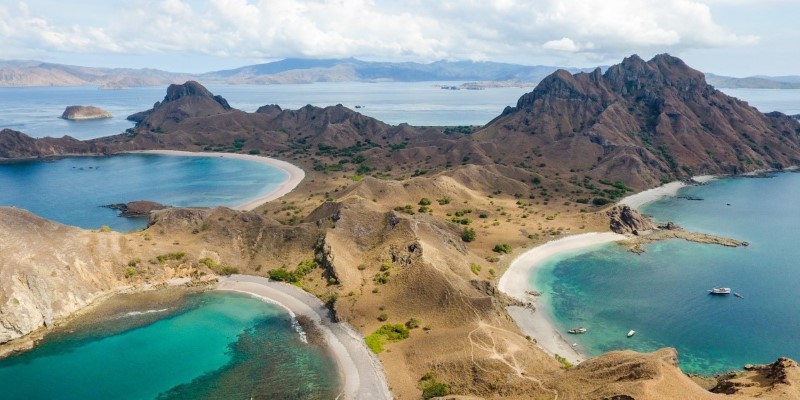Advertisement
Indonesia is famous for its incredible biodiversity, vibrant culture, and tropical beauty, but one destination stands out for its unique charm and raw natural appealthe Komodo Islands. Located in the heart of the Lesser Sunda Islands, this group of islands is home to one of the world's most fascinating creatures: the Komodo dragon. However, there is much more than that prehistoric reptile life on these islands. With rugged beaches and crystal-clear waters to pristine coral reefs, the Komodo Islands are a haven for those who love nature, adventurers, and those looking for a real off-the-beaten-path getaway.
Whether you intend to hike the hills in search of dragons in their habitat or spend leisure time near the sea, this book provides the basic information necessary to make the most of your visit to the Komodo Islands.
The Komodo Islands lie between the islands of Sumbawa and Flores; the easiest way to access them is by flying into the town of Labuan Bajo, a small town that's on the western extremity of Flores. As the gateway to Komodo National Park, one could get to Labuan Bajo from Bali by using daily flights; otherwise, one could go to other major towns within Indonesia. From Labuan Bajo, it will be a short boat ride to the islands themselves, about 1-2 hours, depending on your destination.
Although you can pre-arrange a straight-through boat tour to the islands, many visitors come aboard liveaboard boats to experience a multi-day tour in island hopping while experiencing their available diving and snorkeling experiences. If you're targeting luxury or privateness, there are resorts at Labuan Bajo where package deals come with transfers as well as guided tours for all the islands.
Visiting the Komodo Islands is like stepping into another world, where nature is untouched, and adventure waits at every turn. The Komodo National Park covers over 1,700 square kilometers and includes three main islands: Komodo, Rinca, and Padar, along with numerous smaller islets. Each island offers something unique, and your time in the park can be as relaxed or action-packed as you want.

The Komodo dragon, the worlds largest living lizard, is the star attraction on the Komodo Islands. These massive reptiles can grow up to 10 feet long and weigh more than 150 pounds. Hiking with a park ranger gives you the chance to observe them in their natural environment. The trails are moderate and take a few hours to complete, but the heat and humidity can be intense, so be prepared. While Komodo dragons generally aren't aggressive, they are wild animals, so its important to keep a respectful distance for your safety and theirs.
Beyond the dragons, the Komodo Islands offer some of the most beautiful beaches in Indonesia. Pink Beach, known for its sand tinged with crushed red coral, is perfect for swimming and snorkeling. The surrounding waters are rich with marine life, including sea turtles, vibrant fish, and coral reefs. For diving enthusiasts, the island's waters are a haven, with world-class dive spots like Batu Bolong and Manta Point, home to rare creatures like manta rays. Padar Island is another highlight, offering panoramic views from its rugged hills, making it a photographer's dream.
While the Komodo Islands are celebrated for their natural beauty, the local communities are just as captivating. In Labuan Bajo, you can visit traditional villages where the locals engage in fishing, weaving, and farming. The islanders live closely with nature, and their customs are intertwined with the land and sea. Visiting these villages offers a unique cultural experience and a chance to learn about the island's history. You can also support local artisans by shopping at markets that feature handmade crafts and fresh produce, helping sustain the indigenous way of life.
The best time to visit the Komodo Islands is during the dry season, which runs from April to December. During these months, the weather is hot but manageable, with less rain and clearer skies. The wet season, from January to March, sees higher rainfall and rougher seas, which can make travel and hiking more difficult. However, the wet season is also the best time for birdwatching, as migratory birds flock to the islands.

If you're planning to go diving or snorkeling, the waters around the Komodo Islands are generally warm year-round, but visibility is best from April to November. Keep in mind that this is also the peak tourist season, so expect higher prices and more visitors during these months.
Permits: To enter Komodo National Park, visitors must purchase an entrance permit at the parks gates on Komodo or Rinca Island. The fee supports conservation efforts for wildlife protection.
What to Pack: Pack lightweight, breathable clothing, sunscreen, a hat, sturdy hiking shoes, and plenty of water. As facilities are basic, a camera is essential to capture the islands' stunning landscapes.
Health & Safety: While generally safe, its wise to use mosquito repellent due to malaria risks. If diving, ensure certification and choose a reputable dive operator for safety and a quality experience.
The Komodo Islands offer an unparalleled blend of adventure, natural beauty, and unique wildlife. From the awe-inspiring Komodo dragons to the pristine beaches and world-class diving spots, the islands provide an experience like no other. Whether you're trekking through rugged landscapes, snorkeling in vibrant coral reefs, or immersing yourself in local culture, theres something here for everyone. The Komodo Islands remind us of natures raw splendor and the importance of preserving such remarkable ecosystems. A visit to these islands is not just a tripits a chance to connect with the earths untamed wonders in a truly unforgettable way.
Advertisement

By Sean William/Mar 16, 2025

By Verna Wesley/Dec 21, 2024

By Juliana Daniel/Jan 14, 2025

By Sid Leonard/Mar 17, 2025

By Sid Leonard/Dec 21, 2024

By Celia Kreitner/Jan 14, 2025

By Nancy Miller/Jan 01, 2024

By Madison Evans/Jan 03, 2024

By Celia Shatzman/Mar 18, 2025

By Susan Kelly/Dec 21, 2024

By Darnell Malan/Dec 21, 2024

By Sean William/Jan 14, 2025